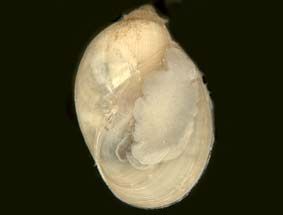Major Group: Gastropoda
Order: Hygrophila
Family: Lymnaeidae |
Descriptive Features: true molluscan gill lost, replaced by various types of secondary gills in some groups
position of eyes relative to tentacles variable, usually at inner bases or at middle of bases
hermaphroditic (simultaneous or protandric)
operculum typically absent, present in 2 basal families (one estuarine)
mantle cavity modified as pulmonary cavity
head and snout spread laterally
radula with many tooth rows (most teeth rather similar)
eyes on inner side of tentacle bases
shell coiled, dextral, ovate, spire short to moderate
mantle edge simple, no pseudobranch
Size: |

|
Austropeplea tomentosa |
|
|

|
Austropeplea |
|
Taxonomic Checklist: Species
Austropeplea 4? species
Bullastra (formerly in Austropeplea) 2? species
Kutikina hispida Ponder & Waterhouse
Lymnaea stagnalis Linneaus (introduced from Europe/Asia)
Pseudosuccinea columella Say (introduced from North America)
Radix peregra Muller (introduced from Europe/Asia) |
|
Distribution: all states
Sensitivity Rating: SIGNAL grade 1
Functional Feeding Group: scrapers |

|
junction of Huon & Picton Rivers, Tahune Tas |
|
|
Ecology: Instream habitat: Nearly all Lymnaeidae species occur in slow flowing or still waters, where they are found in mud or on plants in shallow water. In particular, the liver fluke snails, Austropeplea tomentosa, Lymnaea viridis and Pseudosuccinea columella, live at the edge of springs, small creeks, dam inflows and outflows, irrigation channels, poorly drained drainage channels and in water troughs. Kutikina hispida lives in fast-flowing parts of rivers, although not in the most turbulent areas. It is found attached to vertical or near vertical rocks, boulders or rock faces on the edges of the river, below the water surface. Lymnaeidae species thrive in eutrophic conditions.
Feeding ecology: Lymnaeidae species are scrapers feeding on algae.
Habit: Lymnaeid snails can hang suspended upside down on the surface film by their very wide, muscular foot with the pneumostome open to the air. This may allow them to live in waters with low dissolved oxygen. Austropeplea tomentosa is able to aestivate in dry mud.
Life history: Lymnaeidae species are hermaphrodites capable of self-fertilisation but typically eggs are fertilised in both parents during copulation. Eggs are laid in a gelatinous mass. Young hatch as miniature forms of the adult. Most Lymnaeid snails are short lived. |
| |
Information Sources: Ponder 2001, Smith 1992, 1996, 2000b, Reid & Ponder 2002, Ponder & Waterhouse 1997, Gooderham & Tsyrlin 2202, Lloyd et al 2007
Key to Genera: Smith 1996
Key to Species: Smith 1996 (partial)
Lloyd et al 2007 (liver fluke snails as Lymnaea) |
|
|
|